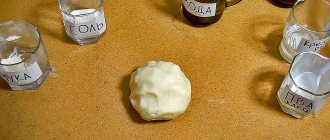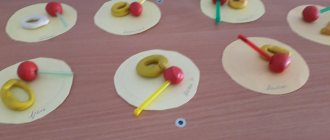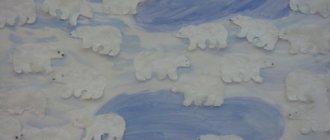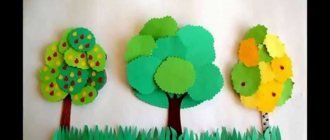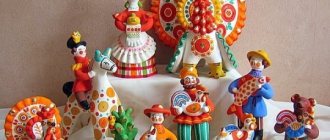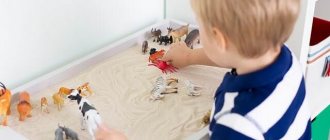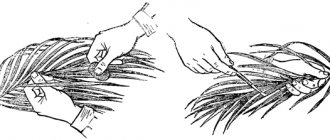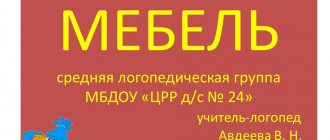Summary of a lesson on appliqué in the preparatory group of a preschool educational institution on the topic: “Elegant dress”
Summary of GCD on appliqué in the preparatory group “
Elegant Dress”
Educational objectives:
—
introduce the profession of a fashion designer, invent and create unusual dresses from paper using the applique technique
- use materials of different textures to create an expressive image;
Developmental tasks:
— develop creative abilities, the ability to think outside the box, do work carefully, and finish what you start.
Educational tasks:
— cultivate accuracy in working with paper and glue, independence
Preliminary work:
looking at illustrations in children's books, watching the cartoon “Cinderella” by C. Perrault. Photo exhibition of festive children's clothing, a doll with a set of outfits.
Material, tools, equipment:
album sheet, glue, brushes, scissors, stencil pattern for a dress made of colored cardboard, white lace napkins, details and decoration elements for the dress, napkins for hands, oilcloth for tables, pictures of ballroom and elegant dresses, picture of a fashion designer
PROGRESS
IN.:
— Guys, do you remember the fairy tale about Cinderella? What dress did Cinderella wear to work? Can she go to the ball in it? Why? Who helped Cinderella find a beautiful outfit? Did she have a choice in choosing an outfit?
IN.:
— Where do you choose your outfits? What should poor Cinderella do? So we helped her solve the task of the evil stepmother, but how can we help her here?
IN.:
— Look at the clothing exhibition. What is she like? (Dressy.) How is it different from everyday clothes? (fabric, color, decoration.) What is this dress decorated with? (Bows, lace.) Is it comfortable to work in such a dress? Clean the floor? (No, it’s long, white lace, satin bows.) Where can you go in such outfits? (For a matinee in kindergarten, at the theater, for a birthday, at a museum.)
IN.:
— Guys, do you know who sews clothes? Before the tailor sews an outfit, an artist will design and draw it. Such artists are called “fashion designers”, “designers”. They come up with new styles of clothes, making them comfortable and elegant. The profession of a fashion designer requires imagination, invention, and a developed sense of beauty. And in order for the tailor to sew the dress correctly, the fashion designer makes a sample and a pattern.
IN.:
— Tell me, what parts does the dress consist of? What elements are on the top of the dress?
IN.:
— Various lines, straight, curved, rounded, can make a dress unusual. They can be in the form of stitching, piping, ruffles, sequins, various draperies, tucks, folds, lines can divide the shape of the dress and hide all the imperfections of the figure.
IN.:
— Guys, would you like to become fashion designers for a while and make a dress for Cinderella?
IN.:
-I invite you to the workshop. What can you and I make a dress from in our workshop? We have multi-colored stencils - patterns. Choose which one you like and take your seats.
IN.:
- Using this pattern, with the help of a lace napkin and details for decorations, you need to make an elegant dress. What tools might you need? (scissors, brush, glue, hand wipes)
IN.:
— Guys, do you remember how to handle scissors and glue (children tell the rules for handling scissors and glue)
IN.:
— We have a step-by-step work plan in our workshop. Tell us what you see in the diagram and where we should start working.
Children tell the stages of work
1. Take a white lace napkin and fold it in half.
2. Unfold it and cut it into two parts with scissors along the fold line.
3. Fold one half of the napkin in half again.
4. Unfold the napkin and fold the right and left sides towards the fold line.
IN.:
- What figure did we get? (triangle). Bend the upper corner of the triangle a little, what have we got? What does it look like?
IN.:
- Now glue the resulting skirt to the dress pattern.
IN.:
- Now let’s do a little warm-up.
Physical exercise: “Dressy shoes”
Dressy shoes, (right foot forward, on the toe)
Dress shoes, (left foot forward, on the toe)
Varnish, with a strap, (right foot forward, on the heel)
And a sole with a heel. (left foot forward, on the heel)
Masha's shoes are just right for going out dancing. (hands on the belt, “dancing”)
IN.:
- Well, shall we continue working? The dress turns out beautiful, but is there something missing? That’s right, it’s not very elegant, so I suggest adding some jewelry. Before you lies the details of decorations for the dress, choose the ones you like and decorate the dresses with them.
Children decorate their dresses and paste them onto a scrapbook sheet.
IN.: -
Oh guys, what beautiful dresses we made, and now let's place our dresses on display, like in a store window, so that Cinderella can choose a dress for the next ball.
IN.:-
I think that Cinderella will be very pleased with your work, but what do you think about your work? Which dress turned out better and neater? What is it decorated with? Which dress would you choose for the ball? What dress would you wear to the theater?
IN.:
— If we glue all your works together, like pages in a book, then we will get the fashion magazine “Dress for the Ball”
“Clothing” Summary of a lesson on applique for children in the preparatory group for school.
“Clothing”
Summary of a lesson on applique for children in the preparatory group for school.
Target:
teach symmetrical cutting of objects (clothing) along a drawn contour.
Tasks:
1. Encourage children to independently complement the image of clothing with details: collar, pockets, embroidery.
Decorate with elements of a geometric pattern, combine colors, use different patterns. 2. Activate the dictionary with phrases: “a shirt has shelves, a back, sleeves,” “a dress
has a skirt, a belt,” “pants consist of two legs and a belt,” clothing pattern. 3. Develop visual, auditory perception, imagination, fine motor skills. 4. Support children's independence and creativity.
Facilities:
Photos on the topic “Clothing”, soundtrack of calm music.
For children: patterns - cardboard patterns, paper of all colors - “material”, glue, brushes, oilcloths, rags, scissors, felt-tip pens, colored pencils. Methods:
Practical: cutting, gluing. Visual: looking at slides depicting clothes: summer, winter, demi-season. Verbal: game “Clothing”.
Result:
Artwork, applique “Clothing”.
Reflection:
positive assessment of children's activities.
Preliminary work:
Examination of photographs depicting clothing: summer, winter, demi-season.
Watch the video “In the Studio”. Reading F. MacDonald “Clothing and Decoration.” Thematic and didactic game “Atelier”. Write descriptive stories on a given topic. Didactic games: “Guess the description”, “What is missing”, “Recognize and name the clothes”. Objectives
Methods, techniques, activities of children
Organizing time.
Communication. Arouse interest in the upcoming activity.
Main part.
Active assimilation, consolidation of knowledge and skills. Examination of slides with images of clothes, activation of children's vocabulary on the topic “Clothing”.
Development of imagination and attention.
Coordination of speech with movement.
Examination of clothing patterns (from cardboard patterns). ( Dresses
, sundresses, shirts, trousers, skirts, sweaters).
Showing the child cutting out the product around the office, commenting on his actions.
Planning upcoming work. The ability to predict the sequence of actions.
The child demonstrates the technique of symmetrical cutting and comments on the actions.
Setting for upcoming activities. Independent activity of children. Exercise in commentary speech. Differentiated assistance. Work on the expressiveness of the application, development of independence and creativity.
- Children, I have good news. I was appointed director of the Button studio. — Clothes from our studio will be demonstrated throughout Russia. — I urgently need cutters and seamstresses. — Do you agree to sew beautiful and elegant clothes? - Yes! -Then we open the Button Studio.
— You already know that clothes can be summer, winter, or demi-season. - Name the clothes according to their intended purpose. -Home, sports, holiday, children's, men's, women's. — What are the details of the dress
. — Skirt, sleeves, belt, back, front. — What parts are shirts made from? — Collar, sleeves, cuffs, back, shelves, pockets. — What parts and parts or pieces do the trousers consist of? - Of two trousers and a belt.
Game "Mend Clothes"
(cutaway pictures) - Children, your clothes urgently need to be repaired.
- Do you want to help? (want) Children choose cut-out pictures of clothes lying on a tray. - Sasha, what did you collect? (suit) - Masha, what parts does your dress
? (back, sleeves, skirt)
Game "Clothes"
Oh, the clothes got dirty, we didn’t take care of them, we handled them carelessly, wrinkled them, got them dirty in the dust. We need to save her and put her in order. Pour water into a basin and add powder. We will soak all the clothes, rub the stains thoroughly, wash them, rinse them, wring them out, shake them. And then we’ll easily and deftly hang everything on the ropes. While the clothes are drying, we will jump and spin.
- What is this? — Halves of clothes, patterns. — Name what clothes can be cut using these patterns ( dresses
, sundresses, sweaters, trousers). -Vladik, can you show us how to use the pattern? (I can)
— You need to fold a rectangular sheet of “fabric” paper into two parts. Determine where the middle of the product will be. Attach the pattern and trace it with a pencil. Cut out clothes. -What happened? (robe)
— Children, we received an urgent order. - Alyosha, tell me where you will start working, what will you do then? — I’ll choose a pattern, “fabric.” I'll trace the pattern with a pencil and cut it out.
- I will take the “fabric” (paper) with my left hand by the fold line. With my right hand I will cut off the edges, turning the workpiece.
- I hope that you know where to start, what to do next, and how to finish.
The children's work is accompanied by calm music (phonogram).
The teacher provides assistance to children: - advice, reminder, clarifying question. - leading questions, showing a sample, cutting out together. The adult reminds the children not to forget to add details to their work: attach buttons, pockets, decorate with embroidery, etc.
Final part.
Revitalization of emotions. Analysis of children's works. Develop speech activity through dialogue and answering questions.
Children hang out their finished “sewing items” and admire them. - Look at how bright and elegant the clothes turned out. “Now I’m sure that the Button atelier will receive orders.”
Conclusion
Develop speech activity through dialogue and answering questions.
— Children, which of you would like to work in your own studio in the future? - I believe that your dreams will come true!
List of used literature
- Komarova T.S. “Lessons in visual arts in a kindergarten preparatory group.” Mosaic-Synthesis. 2011
- The program of education and training in kindergarten, edited by M.A. Vasilyeva, V.V. Gerbova, T.S. Komarova. – 3rd ed., rev. and additional – M. Mosaic – Synthesis. 2005
- Shvaiko G.S. “Lesson in visual arts in kindergarten. Preparatory group for school: Program, notes. A manual for teachers of preschool institutions.” M. Humanitarian ed. VLADOS center. 2000

